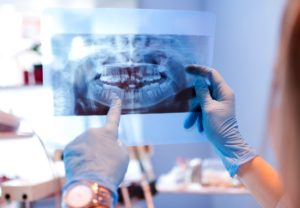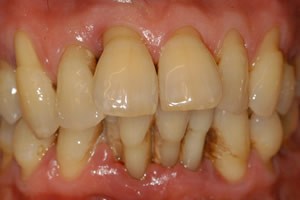Header logo
header top contact widget
Receded Gums
A Periodontal Specialist Explained
Posted on Dec 13, 2019 by William J. Claiborne, DDS MS
Occasionally, I meet someone new who is unfamiliar with my specialty. Although a periodontist may seems to be a “behind the scenes” specialist, our focus actually has an upfront role in your oral health, and beyond.
A periodontist is a dentist who specializes in the prevention, diagnosis, and treatment of periodontal disease, and in the placement of dental implants. Periodontists are also experts in the treatment of oral inflammation. Periodontists receive extensive training in these areas, including three additional years of education beyond dental school.
In addition to having advanced training in the latest techniques for diagnosing and treating periodontal disease, a periodontal specialist is also trained in performing cosmetic procedures that involve gum tissues, such as correcting a “gummy smile”.
Periodontists often treat more problematic periodontal cases, such as people with severe gum disease or have a complex medical history. A periodontist offers a wide range of treatments, such as scaling and root planing (cleaning the infected surface of the root) or root surface debridement (removing damaged gum tissue).
Periodontal specialists can also treat patients with severe gum problems using a range of surgical procedures.
In addition, periodontists are specially trained in the placement, maintenance, and repair of dental implants.
During the initial appointment in our Asheville periodontal office, we typically begin with a review of the patient’s medical and dental histories. This information is important so we are aware of medications being taken or if the patient is being treated for any condition that can affect periodontal care, such as heart disease, diabetes, or pregnancy.
During the examination, we check the patient’s gums to look for gum line recession. We will also assess how the teeth fit together when biting, and check for any loose teeth. An important part of this exam is in the measuring of spaces between gum tissues at the base of teeth.
Using an instrument called a probe that is gently positioned between specific points surrounding each tooth, we determine the depth of periodontal “pockets”. These measurements help us assess the health of your gums. Images (x-rays) may also be taken to revealsthe health of the bone below the gum line.
Periodontal disease, also referred to as “gum disease,” often exists without an individual being aware of its presence. In its early stage, gingivitis, some people even assume that symptoms, such as seeing blood in the sink when brushing, are normal.
Obvious symptoms, such as pain, may not appear until the disease has reached an advanced stage. This is why it is important to be familiar with the signs and symptoms, which include:
• Red, swollen or tender gums or other pain in your mouth
• Bleeding while brushing, flossing, or when eating certain foods
• Gums that are receding (pulling away from the teeth) or make the appear teeth longer than normal
• Loose or separating teeth
• Pus between your gums and teeth
• Sores in your mouth
• Persistent bad breath
• A change in the way your teeth fit together when you bite
• A change in the fit of partial dentures
If you notice any of these symptoms, be sure to contact your dentist or periodontist without delay. Gum disease will only worsen without treatment.
Who Should See a Periodontist?
Some patients’ periodontal needs can be managed by their general dentist. However, patients who are experiencing signs and symptoms of moderate or severe levels of gum disease or have more complex cases receive the most efficient and effective care through team treatment between a general dentist and periodontist.
Restoring your gums to a healthy state is important! As research continually shows, gum health is intricately connected to overall health. Oral bacteria of periodontal disease has been linked as a trigger for more and more chronic diseases, including heart disease, some cancers, stroke, memory loss, diabetes, and arthritis. Having prompt periodontal treatment by a trained periodontal specialist may lower the risk for more serious, and even deadly, diseases and health conditions.
If you are experiencing any of the symptoms associated with periodontal disease, a referral is not required. Call 828-274-9440 and we will be happy to assist you.
If you do not have a general dentist, we can also refer some who are near to you and we know to provide gentle, thorough and appropriate care for their patients’ needs.
Obesity Increases Risk Of Gum Disease.
Posted on Nov 20, 2019 by William J. Claiborne, DDS MS
Imagine one-third of your body being made up of maple syrup.
Sounds pretty absurd, doesn’t it? Yet, for Americans who are categorically obese, this imagery is actually a good description.
Obesity is when fat makes up over thirty percent of body mass. According to the Centers For Disease Control & Prevention (CDC), adults in the U.S. who are categorized as obese is at nearly 40 percent! Another 30 percent are categorized at overweight. That’s two-thirds of adults in the U.S. who have too much fat makeup.
And it’s not just adults over the age of 20 who have this problem. Sadly, nearly 30 percent of children are overweight or obese as well.
In North Carolina, over 63 percent of adults are either overweight or obese, according to a study by the Reasons for Geographic and Racial Differences in Stroke (REGARDS) study. (https://onlinelibrary.wiley.com/doi/full/10.1002/oby.20451)
The problems associated with being overweight and obese are many, and can be deadly. Obesity seems to trigger a predisposition to a variety of serious health conditions and diseases. These include increased risk of stroke, certain cancers, coronary artery disease, and type 2 diabetes.
In addition to the added and unnecessary load that strains the back, knees and ankles, the challenges continue. Obesity decreases lifespan, up to an estimated 20 percent of people who are severely obese. (https://www.nejm.org/doi/full/10.1056/NEJMsr043743)
As 2019 holiday indulgences (often sugary and carb-laden) are before us, many of us also follow the season with with the traditional new year’s resolution of “lose weight” at the top of the list. Along with improved health and greater confidence in overall appearance, we’d like to add another reason to reach your goal.
Chronic inflammation is a known side effect obesity. Why does this matter to a Periodontist? Obesity is also known to exacerbate other inflammatory disorders, including periodontitis (advanced gum disease). To be clear, periodontal disease is also the nation’s leading cause of adult tooth loss.
Research has shown that obese adults have a 6 times higher potential to develop periodontal (gum) disease. As a periodontal specialist my goal is always to help patients achieve optimal oral health. Although discussing the risks of periodontal disease with obese patients can be a sensitive issue, this is without judgement of why they are overweight but rather how we can help them enjoy a healthier smile.
Most of us know – losing weight is not a process that is either easy or quick. Add to this that research has shown that factors such as sleep quality and what we eat (as much as how much we eat) can cause the brain to make the challenges of weight loss even greater.
For one, studies have shown that sugar can be addictive. Sugar consumption even activates the same regions in the brain that react to cocaine. For individuals who admit to having a “sweet tooth,” trying to stay within the recommended 6 teaspoons per day limit can be a battle when we are truly “addicted.” (https://www.brainmdhealth.com/blog/what-do-sugar-and-cocaine-have-in-common/)
Insufficient sleep also complicates the brain’s ability to regulate hunger hormones, known as ghrelin and leptin. Ghrelin stimulates the appetite while leptin sends signals of feeling full. When the body is sleep-deprived, the level of ghrelin rises while leptin levels decrease. This leads to an increase in hunger.
The National Sleep Foundation states that “people who don’t get enough sleep eat twice as much fat and more than 300 extra calories the next day, compared with those who sleep for eight hours.” (https://www.sleepfoundation.org/sleep-topics/the-connection-between-sleep-and-overeating)
As difficult as losing weight can be, it is important to be aware of risk factors that can make you more suspectible to gum disease. Initial symptoms include gums that are tender, swollen, and may bleed when brushing. This stage, known as gingivitis, is actually reversible with prompt, thorough oral hygiene.
As gum disease worsens, however, the inflammation of oral bacteria can lead to persistent bad breath, receded gums that expose sensitive tooth roots, and gums that darken in color. If untreated, pus pockets can eventually form and the base of some teeth and tooth loosening can require removal.
Armed with this information, we want to help all patients, with overweight or obese adults especially, to take added precautions to maintain good oral health, both at home and through regular dental check-ups.
Avoiding periodontal disease is particularly important since its infectious bacteria have been linked to serious health problems. These include heart disease, diabetes, arthritis, some cancers, preterm babies, impotency, and Alzheimer’s disease.
If you are experiencing symptoms of gum disease, however, it is vital to be seen by a periodontist as soon as possible to halt further progression. A periodontist is a dental specialist who has advanced training in treating all stages of gum disease as well as in the placement of dental implants. The earlier the treatment, the less involved treatment requirements will be. Gum disease will not improve without professional care.
Call 828-274-9440 to schedule an initial examination or begin with a consultation.
Using A Manual Or Electric Toothbrush Could Make A BIG Difference.
Posted on Sep 11, 2019 by William J. Claiborne, DDS MS
If you use an electric toothbrush, that can help in the prevention of tooth loss. However, it’s but one part of the steps needed for thorough oral hygiene at home.
Findings of an 11 year study published in the Journal of Clinical Periodontology tracked the oral health of over 2800 adults. Their use of electric toothbrushes was monitored to watch for periodontal disease, cavities, and the number of natural teeth.
Participants were examined in 2002 – 2006, with 18 percent being electric tooth brush users. Follow ups were conducted after six and 11 years. At the time of their 11 year follow up, 37 had converted to using electric toothbrushes.
The study showed electric brushing promoted better gum health and slower progression of gum disease. Electric tooth brushing also related to a reduction in tooth loss by 20 percent (compared to those who brush with manual toothbrushes). The study did not reveal measurable reduction in cavities, however.
Although more adults are using them, their long-term effectiveness has not been proven to be significant. It is suspected that this is due to technique more than the brushing tool itself. For manual brushers, a major hazard with manual brushes is one’s choice of bristles. Stiffer bristles can be very damaging.
If you use a hard bristle tooth brush, you may be damaging tooth enamel and gum tissues. People often feel they need to press down firmly as they brush and use a scrubbing, ‘back & forth’ motion. This action can wear down the protective shell of tooth enamel, leaving teeth more vulnerable to decay.
Another problem with using a hard bristle tooth brush is its ability to damage tender gum tissues. If the bristles on your toothbrush are fanned out after a couple of months, it’s because you are applying too much pressure when brushing.
The ideal technique for brushing teeth is applying gentle pressure on the brush in a swirling motion. By using a circular pattern over both sides of each tooth and along the tops, teeth are cleansed without wearing away gum tissues.
This is where electric toothbrushes can help greatly. Many of the newer models include timers to indicate the time needed for each quadrant of your mouth. This is your teeth divided into 4 sections. They also warn you when you are using too much pressure.
While tooth enamel is important, equally so are the health of your gum tissues. The gums provide a seal around the base of each tooth. This seal helps to prevent the entry of bacteria that can lead to periodontal (gum) disease, which the nation’s leading cause of adult tooth loss.
As devastating as tooth loss can be to one’s overall health, as we now know that the bacteria of gum disease can enter the bloodstream. Research has shown this infectious bacteria can trigger inflammatory reactions elsewhere in the body, correlating to heart disease, stroke, high blood pressure, some cancers, diabetes, arthritis, impotency, preterm babies and more.
Whether using a manual or electric tooth brush, it is necessary to brush twice a day for effective results. In order to thoroughly remove the sticky film of plaque from teeth, you should also brush at least two minutes each time.
Plaque is a buildup of oral bacteria that coats teeth and gums. If not removed daily, it forms a hardened mass of calculus (or tartar) that attaches to teeth. This is what you may feel your hygienist scraping off teeth during cleanings since it cannot be brushed or flossed away.
Another place for oral bacteria to thrive are the grooves in the tongue. These offer a dark, warm and moist environment for bacterial reproduction. To uproot these organisms (that reproduce rapidly), use your toothbrush to brush your tongue after brushing teeth. Be sure to reach the back of the tongue where the majority of oral bacteria are embedded. Swish with water several times after.
Another way to improve gum health, lower cavity risk, and prevent tooth loss is through flossing. It is estimated that only 31 percent of American adults floss on a daily basis. Because brushing cannot dislodge all food particles caught between teeth, daily flossing should be a part of oral hygiene routines.
Flossing removes trapped bits of food remain in the mouth, which feeds oral bacteria and helps them to quickly multiply. Proper flossing is easy for those who are in the habit of it and takes under a minute each day. For those who have problems with manual dexterity or find the maneuver awkward, water flossers are effective alternatives and easy to use.
Practice the recommended techniques mentioned above and you’ll not only do a better job at having a clean mouth, you’ll find your time at the sink requires less effort. If you feel you may be experiencing symptoms of periodontal disease, however, don’t delay. You should be seen at your earliest convenience for treatment since this disease will only worsen over time.
Signs of gum disease include tender gums that bleed easily when brushing, gums that darken in color to red (versus a healthy pink), frequent bad breath, and gums that pull away from teeth (receded gums) and expose darker root areas of the tooth.
If you’ve noticed any of these, please know that the condition will only worsen without treatment. As a periodontist, I specialize in gum tissues (as well as dental implants). Our environment optimizes patient outcomes and comfort throughout treatment.
Call 828-274-9440 to learn more.
React To Gum Disease EARLY To Save Time & Money On Treatment.
Posted on Aug 08, 2019 by William J. Claiborne, DDS MS
“Hindsight is 20-20.”
This saying describes how, if we’d “known then what we know now…” we may have taken a different course of action for a better outcome.
In cases where gum disease develops or tooth loss occurs, patients often wish they could turn back the hands of time. Many patients who have acquired gum disease or had teeth replaced because of it are now highly-committed to their oral health. They often tell us, “I wish I’d taken better care of my mouth before,” now realizing how problems can be avoided as well as the benefits of good oral health.
Periodontal (gum) disease and (often) its subsequent tooth loss are, simply put, products of bacterial overload in the mouth. Our mouths are constantly being supplied with sustenance for these organisms. Bacteria are able to thrive through food that enters, especially sugars, and other bacteria-laden items put into the mouth. As bacteria thrive, they are able to reproduce very rapidly.
When bacteria levels become more than the immune system can tackle, infection can set in. Just as a cut or scrape on the skin that is not kept sufficiently clean can become infected, oral bacteria can cause an infection to develop in the mouth. This accumulation of bacteria can evolve into gum disease, which is an inflammation that attacks teeth, oral tissues and the bone structures that support tooth roots.
Gum disease symptoms include sore gums that bleed when brushing, frequent bad breath, gums that pull away from the base around teeth, gums that darken in color. As it worsens, pus pockets may form on the gums at the base of some teeth. In advanced stages, gum disease causes teeth to loosen and eventually require removal.
Gum disease often progresses because people are unaware that bleeding or receding gums is actually a symptom. Insufficient brushing, failing to floss and not having regular dental cleanings form a path that begin the process.
Insufficient care can lead to a build-up of bacteria, known as plaque. Plaque is a sticky (or “fuzzy”) film you feel on teeth when not removed on a regular basis. In just 48 hours, plaque can transform into a cement-hard colony of oral bacteria that attaches to teeth. This hardened form of bacteria is known as tartar or calculus. Unlike plaque, tartar cannot be brushed or flossed away.
As your mouth is enduring the repercussions of oral bacteria accumulation, gum tissues and tooth enamel are attacked. Once this infectious bacteria has penetrated below the gum line, dental treatment is necessary to halt its continued development and restore healthy gums
With prompt and proper measures, however, you can halt and reverse the need for dental treatment and avoid the repercussions of gum disease.
Gingivitis is the initial stage of gum disease. Symptoms typically include gums that are tender in spots and some bleeding when you brush. These are warning signs that signal an immediate need for attention.
Begin by twice daily brushing with a soft bristle tooth brush and use a fluoridated tooth paste. Brush for at least two minutes each time. Floss daily. Be sure not to pop the floss between teeth to avoid damaging tender gums. Move the floss in a back-&-forth motion between teeth to ease it down so you can scrape the sides of each tooth.
You can remove a tremendous amount of oral bacteria by using a tongue scrapper daily. Or, brush your tongue with your tooth brush at the end of each brushing. This helps to dislodge bacteria that is embedded in the grooves of the tongue.
Drink lots of water during the day. This will help keep saliva flow at ample levels. Saliva is designed to move oral bacteria from the mouth on a consistent basis. Oral dryness is the enemy. Avoid foods and beverages that are drying to oral tissues such as caffeine, alcohol, and spicy foods. Also, try to minimize the amount of sugar and carbohydrates you consume. These foods amplify the reproduction of oral bacteria.
If you smoke, consider using an oral rinse that replenishes moisture in the mouth. The chemicals in cigarette smoke are verey drying to oral tissues. Some oral rinses are specifically designed for producing moisture. Remember, oral dryness gives bacteria a favorable environment for reproduction.
When it comes to the initial formation of gingivitis, these steps will help relieve gum tenderness and potential to bleed within a week or so. If you do not see improvement after 2 weeks of diligent measures, see a periodontal specialist as soon as possible.
A periodontist is a dental specialist who can determine your precise level of gum disease and the most appropriate treatment to restore good oral health.
Call 828-274-9440 if you have questions about your gums or if you are experiencing any symptoms associated with gum disease.
Recent Posts
Categories
Archives
- September 2024
- August 2024
- July 2024
- June 2024
- May 2024
- April 2024
- March 2024
- February 2024
- January 2024
- December 2023
- November 2023
- October 2023
- September 2023
- August 2023
- July 2023
- June 2023
- May 2023
- April 2023
- March 2023
- February 2023
- January 2023
- December 2022
- November 2022
- October 2022
- September 2022
- August 2022
- July 2022
- June 2022
- May 2022
- April 2022
- March 2022
- February 2022
- January 2022
- December 2021
- November 2021
- October 2021
- September 2021
- August 2021
- July 2021
- June 2021
- May 2021
- April 2021
- March 2021
- February 2021
- January 2021
- December 2020
- November 2020
- October 2020
- September 2020
- August 2020
- July 2020
- June 2020
- May 2020
- April 2020
- March 2020
- February 2020
- January 2020
- December 2019
- November 2019
- October 2019
- September 2019
- August 2019
- July 2019
- June 2019
- May 2019
- April 2019
- March 2019
- February 2019
- January 2019
- December 2018
- November 2018
- October 2018
- September 2018
- August 2018
- July 2018
- June 2018
- May 2018
- April 2018
- March 2018
- February 2018
- January 2018
- December 2017
- November 2017
- October 2017
- September 2017
- August 2017
- July 2017
- June 2017
- May 2017
- April 2017
- March 2017
- February 2017
- January 2017
- December 2016
- November 2016
- October 2016
- September 2016
- August 2016
- July 2016
- June 2016
- May 2016
- April 2016
- March 2016
- February 2016
- January 2016
- December 2015
- November 2015
- October 2015
- September 2015
- August 2015
- July 2015
- June 2015
- May 2015
- April 2015
- March 2015
- February 2015
- January 2015
- December 2014
- November 2014
- October 2014
- September 2014
- August 2014
- July 2014
- June 2014
- May 2014
- April 2014
- March 2014
- February 2014
- January 2014
- December 2013
- November 2013
- October 2013
- September 2013
- August 2013
- July 2013
- June 2013
- May 2013
- April 2013
- March 2013
- February 2013
- January 2013
- December 2012
- November 2012
- October 2012
- September 2012
- August 2012
- July 2012
- June 2012


